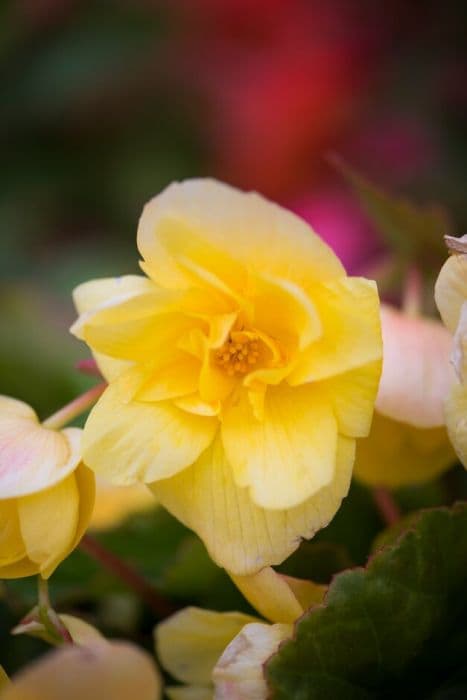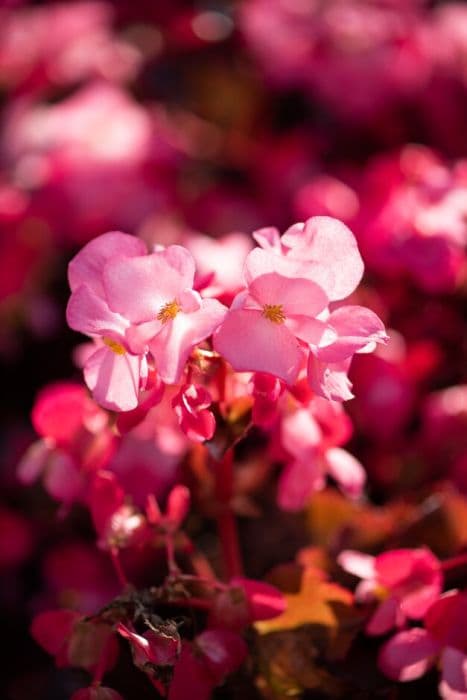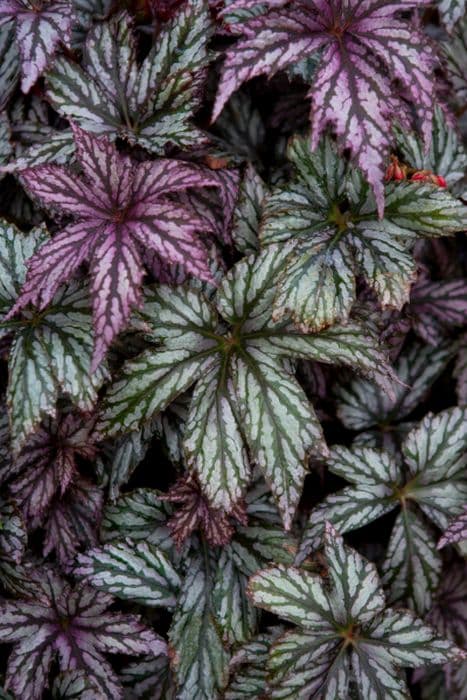Begonia Begonia 'Laurie's Love' (C)

ABOUT
Begonia 'Laurie's Love' is a cultivated variety of begonia known for its vibrant and attractive foliage. The leaves are the star attraction of this plant, displaying a rich tapestry of colors. They are often heart-shaped or wing-like in appearance, showcasing a mix of deep green and burgundy hues. The foliage may have a glossy sheen, with the reddish tones becoming more pronounced in certain environmental conditions. Veins may appear as contrasting colors, creating a standout pattern against the main leaf color. This begonium variety also produces flowers which, although not as eye-catching as its foliage, add an extra layer of interest. The blooms are typically small and may come in shades like pink or white that cluster on the stem, creating a delicate contrast to the robust leaves. The overall impression of Begonia 'Laurie's Love' is one of lushness and vivid color, with leaves that may have a somewhat ruffled or serrated edge, adding to the plant's ornamental appeal. This begonium could be a dazzling addition to plant collections, particularly for those enthusiasts who appreciate the beauty of intricately patterned foliage and the rich, warm tones that this variety offers.
About this plant
 Names
NamesSynonyms
Laurie's Love Begonia, Wax Begonia, Fibrous Begonia, Semperflorens.
Common names
Begonia 'Laurie's Love'
 Toxicity
ToxicityTo humans
Begonias, including 'Laurie's Love', contain compounds that can be mildly toxic to humans if ingested. If parts of the plant are consumed, they can cause irritation of the mouth, lips, throat, and tongue due to the presence of oxalate crystals. Symptoms can include a burning sensation, swelling, and difficulty swallowing. In severe cases, gastrointestinal symptoms like nausea, vomiting, and diarrhea may occur. It is advisable to keep begonias out of reach of children who might accidentally ingest the plant material.
To pets
Begonias, including 'Laurie's Love', are toxic to pets. Ingesting any part of the plant can lead to symptoms such as drooling, vomiting, and difficulty swallowing due to the irritation caused by oxalate crystals. In severe cases, ingestion can result in kidney failure or other serious complications. Signs of poisoning may appear shortly after a pet consumes the plant. If you suspect your pet has ingested begonias, it is essential to contact a veterinarian immediately.
 Characteristics
CharacteristicsLife cycle
Perennials
Foliage type
Evergreen
Color of leaves
Mixed
Flower color
Pink
Height
1-2 feet (30-60 cm)
Spread
1-2 feet (30-60 cm)
Plant type
Herb
Hardiness zones
10
Native area
South America
Benefits
 General Benefits
General Benefits- Easy to care for: Begonia 'Laurie's Love' is a low-maintenance plant, making it suitable for gardeners of all levels of experience.
- Aesthetic appeal: It has attractive foliage and vibrant flowers, which can enhance the beauty of any garden or indoor space.
- Versatility: This plant can be grown both indoors and outdoors, provided it is given the right conditions.
- Brightens shaded areas: It thrives in shaded or partly shaded areas, where many other plants might struggle to grow.
- Seasonal interest: It produces colorful blooms during its flowering season, adding visual interest to the environment.
- Compact growth: It's suitable for container gardening or smaller spaces due to its compact growth habit.
 Medical Properties
Medical PropertiesThis plant is not used for medical purposes.
 Air-purifying Qualities
Air-purifying QualitiesThis plant is not specifically known for air purifying qualities.
 Other Uses
Other Uses- Begonias like 'Laurie's Love' can be used to create natural art pieces by pressing their colorful leaves and flowers into paper or embedding them in clear resin, making unique botanical artworks.
- In micro-landscaping or miniature gardens, the compact size and ornamental leaves of Begonias are used to add a variety of textures and colors.
- Its flowers can be crystallized with egg whites and sugar to create edible decorations for cakes and desserts, adding a special touch to culinary presentations.
- Begonia leaves can serve as natural color indicators in educational settings, as some species' leaves change color to indicate excess sun or lack of nutrients.
- In crafting, Begonia leaves with unique patterns can be used as stamps by coating them in paint and pressing them onto fabric or paper to create repeated motifs.
- The flowers and leaves of Begonias can be used in potpourri blends, adding aesthetic appeal and a subtle fragrance to the mix.
- As a muse for artists and photographers, Begonias offer vibrant colors and interesting forms to inspire paintings, drawings, or intriguing photographic compositions.
- Begonia petals can be used in homemade dyes for fabrics, providing a range of colors depending on the mordant used in the dyeing process.
- The plant's leaves and flowers can be used in sensory gardens, as their varied textures and shapes offer tactile experiences for visitors.
- In terrariums, Begonias like 'Laurie's Love' add a splash of color and can create a focal point due to their distinctive foliage among other, more subdued plants.
Interesting Facts
 Feng Shui
Feng ShuiThe Begonia is not used in Feng Shui practice.
 Zodiac Sign Compitability
Zodiac Sign CompitabilityThe Begonia is not used in astrology practice.
 Plant Symbolism
Plant Symbolism- Beware: Begonias traditionally symbolize a sense of caution or warning. 'Laurie's Love' could carry a message to be wary in love or personal affairs.
- Deep Thoughts: The diverse and striking appearance of the begonia can prompt introspection or encourage engagement with complex ideas.
- Gratitude: Giving a begonia, such as 'Laurie's Love,' can express thankfulness or appreciation for a kind act or friendship.
- Individuality: Begonias, with their unique foliage and blooms, are often associated with being unique or standing out from the crowd.
- Harmony: The balanced and symmetrical form of 'Laurie's Love' can represent a sense of harmony and peace in one's life.
 Water
WaterBegonia 'Laurie's Love', commonly known as Laurie's Love Begonia, prefers evenly moist soil without becoming waterlogged. Water the plant when the top inch of the soil feels dry to the touch; this will typically be once a week, but frequency can vary with indoor conditions. It's crucial to avoid wetting the foliage to prevent fungal diseases. Depending on pot size and environmental conditions, you might water with approximately 8-16 ounces of water each time. Always allow excess water to drain away, and never let the pot sit in standing water.
 Light
LightLaurie's Love Begonia thrives best in bright, indirect light. Avoid direct sunlight as it can scorch the leaves. An ideal spot would be near an east-facing or north-facing window where it can receive gentle morning light or diffused sunlight throughout the day. If the natural light is too intense, use sheer curtains to filter the light and protect the plant.
 Temperature
TemperatureLaurie's Love Begonia does well in temperatures between 65 to 75°F, which is considered ideal for its growth. The plant should be protected from temperatures below 50°F as cold can damage it. Always avoid placing Laurie's Love Begonia in areas with drafts or sudden temperature changes.
 Pruning
PruningPruning Laurie's Love Begonia is essential for maintaining its shape and encouraging bushier growth. Prune lightly throughout the growing season to remove any dead or yellowing leaves, and to promote new growth. The best time for more extensive pruning is late winter or early spring before new growth begins.
 Cleaning
CleaningAs needed
 Soil
SoilThe best soil mix for Begonia 'Laurie's Love' would be light, well-draining, and rich in organic matter, such as a combination of peat moss, perlite, and pine bark. The optimal soil pH range for Begonias is slightly acidic to neutral, around pH 6.0 to 7.0.
 Repotting
RepottingBegonia 'Laurie's Love' should be repotted every 1-2 years, or when it becomes root-bound and the soil is exhausted. Early spring, before the onset of active growth, is the ideal time for repotting this plant.
 Humidity & Misting
Humidity & MistingBegonia 'Laurie's Love' thrives in high humidity conditions, preferring a humidity level between 50% and 70%. Regular misting or a humidity tray can help maintain these conditions indoors.
 Suitable locations
Suitable locationsIndoor
Place in bright indirect light with high humidity.
Outdoor
Keep in shade or semi-shade; protect from extreme temps.
Hardiness zone
10-11 USDA
 Life cycle
Life cycleBegonia 'Laurie's Love', commonly known simply as Begonia, begins its life cycle as a seed, which, when sown in a moist soil mix and provided with warmth and light, will germinate. The seedling emerges and develops true leaves, at which point it can be considered a juvenile plant. As it matures, the Begonia enters its vegetative stage, characterized by the growth of foliage and the development of a strong root system. Once mature, it enters the flowering stage, where it produces blooms that may be pollinated, leading to the production of seeds, thereby completing its reproductive cycle. In perennial Begonias, the plant may go into a period of dormancy during colder months, with reduced growth or apparent inactivity, before resuming growth in the spring. If conditions are optimal, the cycle continues year after year, with the plant potentially producing offsets that can be separated and grown as new individuals.
 Propogation
PropogationPropogation time
Spring-Early Summer
Propogation: Begonia 'Laurie's Love', commonly referred to as Begonia, is effectively propagated during its active growing phase, which typically spans from spring to early summer. The most popular method of propagation of this plant is by stem cuttings. One would take a healthy stem cutting, about 3 to 4 inches long (roughly 7.5 to 10 centimeters), and ensure that it has at least one or two nodes where leaves attach, as these areas contain the cells necessary for root growth. The cutting can then be dipped into a rooting hormone powder to stimulate root development and planted in a well-draining soil mix. The soil should be kept moist but not waterlogged, and the cutting should be placed in a warm location with indirect sunlight. Rooting typically occurs within a few weeks, after which the new plant can be treated as an adult Begonia.





![Begonia [Devotion]](/_next/image?url=https%3A%2F%2Fplants-admin.emdemapps.com%2Fimages%2Fplants%2F%2Fimages%2F604b58183573b.png&w=640&q=75)



